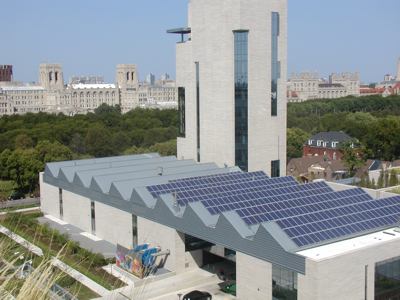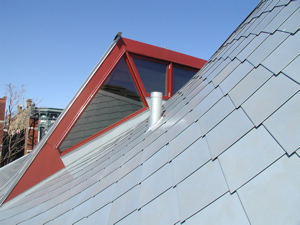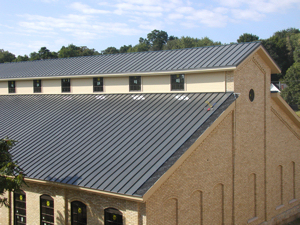Zinc Roofing: Good Design Means A Lifetime Of Service
By Steve Shull, CSI, CDT, LEED AP®
Midwest Regional Sales Manager - RHEINZINK America, Inc.
 |
Shown above, the University of Chicago Logan Art Center. The project has roof-mounted solar panels over zinc roofing panels manufactured by Morin - a Kingspan Group Company. Click image to enlarge. |
Material selection directly impacts the performance, aesthetics and durability of a structure. A roof fabricated from architectural zinc (titanium-zinc alloy) may be the best metal value for many steep-slope applications. Several prominent roof manufacturers now offer zinc as a natural metal upgrade to painted and metallic coated metals. While each fabricator and system partner offer unique advantages, all zinc roofs should follow the same fundamental design and specification guidelines.
A roof that provides lasting character and endurance does not have to be difficult as long as the design and application fits the material. For zinc, a good roof design and installation are more effective than any warranty document.
 |
Shown above is a close-up of a mixed-use residential project in Chicago incorporating RHEINZINK square tile roofing. Click image to enlarge. | |
 |
Above is the 11 West Main Rehab project in Carpentersville, IL. It is topped with RHEINZINK single-lock standing seam roofing. Click image to enlarge. |
To achieve the 80-100 year service life, construction documents should address the following issues specific to the unique requirements of a zinc roof:
1. Slope. A higher roof slope is better and directly affects the service life of the metal. Steeper slopes also increase the aesthetic value that highlights the metal. Its beauty endures longer when pitch is added.
2. Ventilation & more. Raising the zinc panel off the roof underlayment with a material that creates a capillary break will help the zinc survive if moisture gets behind the panel. An approved structured underlayment creating 3/8” airspace allows the concealed zinc surface to dry. The nylon ventilation mat also serves as a slip plane and reduces sound transmission through the roof assembly. Moisture retaining materials like red rosin paper should never be used with zinc.
3. Bending Radius & Temperature. Fabricating zinc into a panel or trim profile induces stress on the metal. A sharp bending angle can stress metal to the point of fracture. Mechanical folding beams and press dies must provide a soft bending radius of at least 1.5 times the material thickness (2x is better). Applying heat to the bending area (especially below 48° F.) can also ensure the zinc does not crack.
4. Expansion & Contraction. Titanium-Zinc alloy has a coefficient of expansion slightly less than aluminum (1/4” per 10 LF per 100° F.). Zinc roof profiles are typically attached indirectly with concealed clips that allow movement of the panel. For long panels, 1-piece fixed clips should be used within the “fixing” zone and 2-piece sliding clips for the balance of the seam.
5. Other Material Run-off. Zinc run-off is clear and will not harm other materials. Run-off from certain materials like copper, however, is corrosive to zinc. Caution should be used when other products drain on to zinc. Wet mortar, acidic woods, etc. can also adversely affect zinc by pitting or staining when up-slope run-off is not pH neutral. Generally, it is good practice to minimize drainage of other materials onto zinc surfaces.
6. Dry Joints at Eave. As a precaution, it is advised to eliminate any sealants at the eave. Dry-joint construction allows any up-slope moisture or condensation an escape path. Joint sealants at the low?points plug up potential weep holes where water could potentially leave the system.
Zinc Detail Opportunities
Metal has huge advantages over other roofing materials such as its ability to be folded. Bending metal to control where water flows (or doesn’t flow) is even easier with a soft metal like zinc. Water checks, pinched seams, integral cleats, bread-pan ends, etc. provide lifetime metal solutions that do not rely on sealants that can eventually fail. Zinc can also be soldered making watertight connections and transitions with metal adhesive. Malleable unpainted metals offer the opportunity for crafted details that minimize the chances for water infiltration.
Zinc – The Natural Low-Impact Metal
A zinc roof can be a strong design feature and an Environmental Policy Statement. A natural grey patina is formed after repeated exposure to wetting and drying cycles. Zinc is an unpretentious “green building” product that is a great color compliment to many other natural materials. Ask your zinc manufacturer for a copy of their Environmental Product Declaration (per ISO 14025 and EN 15804). Compare architectural zinc with any other natural or coated metal. Zinc is a “green” roofing alternative.
Zinc is a crafted metal that can provide many design opportunities while keeping a low environmental profile. Standing seam, interlocking tile, strip shingles, horizontal seam profiles can be custom fabricated or mass produced by a number of metal roofing manufacturers. Regardless of the panel fabricator, there are basic guidelines that must be followed during every project design. Zinc alloys (per ASTM B-69, for Architectural Rolled Zinc, Type 1 and Type 2) provide a grey choice for color that never fades away. Consider zinc as a roofing material solution for clients who want to minimize life-cycle costs while maximizing the design “buzz”.
About RHEINZINK America Inc.
 RHEINZINK America, Inc. is a North American provider of architectural zinc used in the fabrication of roofing, facades, rainware and architectural details. For more information visit www.rheinzink.us.
RHEINZINK America, Inc. is a North American provider of architectural zinc used in the fabrication of roofing, facades, rainware and architectural details. For more information visit www.rheinzink.us.